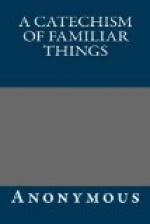Deciphered, read, understood, made out.
Unintelligible, that cannot be understood.
Expounded, explained, interpreted.
Were Hieroglyphics employed before or after Alphabetic Writing?
They were undoubtedly employed at first from necessity, not from choice or refinement; and would never have been thought of, if alphabetical characters had been known. This style of writing must be reckoned as a rude improvement upon picture-writing, which had previously been used. Hieroglyphics were employed by the Egyptian priests in after times, as a kind of sacred writing, peculiar to themselves, and serving to give an air of mystery to their learning and religion, though fallen into disuse for other purposes.
What materials were employed by ancient nations in Writing?
The Eastern nations used tables of stone, brass, and wood, so that the characters were engraved instead of being written in the usual manner. The instrument used in writing on wood, was made of metal, and called a style. For stone, brass, &c., a chisel was employed. When the bark and leaves of trees, skins, and other materials of a more pliant nature, superseded the above-named tables, the chisel and the style, or stylus, gave way to the reed and cane, and afterwards to the quill, the hair pencil (as now used by the Chinese,) and the convenient lead pencil.
Engraved, inscribed
with the graver, a tool used in
engraving on stone,
&c.
Pliant, yielding, easily bent.
Have not the various nations among whom this useful art has been cultivated, adopted different ways of arranging their written characters?
Yes. The Hebrews, Chaldeans, Syrians, Arabians, and Egyptians, begin each line on the right side, and write towards the left. The Greeks, Latins, and all European nations, write from left to right. The natives of China, Japan, Cochin China, Corea, &c., write from the top to the bottom of the page.
Where are Cochin China, and Corea?
Cochin China is a country situated in Eastern Asia. Corea is a peninsula of Asia, subject to China.
What is meant by Science?
A clear and certain knowledge of anything founded on self-evident principles, or demonstration. The term is, however, more particularly applied to a systematic arrangement of the principles relating to any branch of knowledge, and is employed in this sense in opposition to art: thus the theoretical knowledge of chemistry is ranked as a science, but the practical part is called an art; thus it is sometimes spoken of as a science, sometimes as an art.
Practical, relating to action, not merely speculative.
What is Chemistry?
A science which enables us to discover the peculiar properties of natural bodies, either in their simple or compound state, and the elementary or first principles of which they are composed, by the processes of analysis and combination. Chemistry treats of those changes in natural bodies which are not accompanied by sensible motions.




